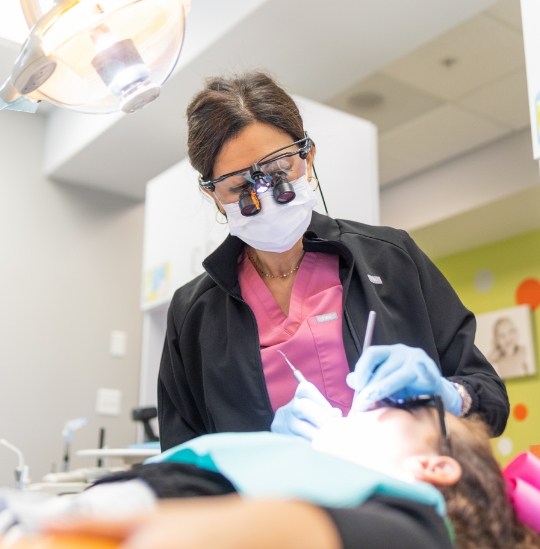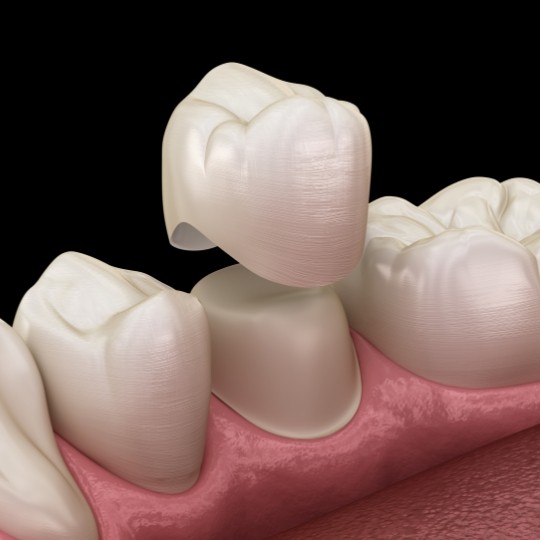Did you know that according to the CDC, nearly a third of children between two and five years old are affected by tooth decay? While this is shocking, Brush Pediatric Dentistry encourages families to focus on preventive oral care so they can avoid issues that require more invasive treatment. However, accidents happen, whether that’s an unexpected broken tooth or cavity, and then pediatric restorative dentistry becomes necessary. If your child’s smile needs a little help, be sure to contact our Downers Grove or Hinsdale pediatric dental office today for an appointment!
Why Choose Brush Pediatric Dentistry for Your Child’s Restorative Dentistry?
- We Accept & Maximize Dental Insurance
- Friendly & Welcoming Dental Team
- Same-Day Emergency Appointments
Dental Fillings
If your child experiences a cavity, the first course of treatment we normally use involves a filling. This material literally fills the space in their teeth eaten away by the cavity and helps restore its strength. Whenever possible, we will always use tooth-colored fillings. They are made of a plastic-based composite resin material that is completely biocompatible (no metal allergies!). It’s able to firmly bond directly to the tooth, and like the name indicates, it can be shaded to match the natural color of your child’s enamel.
However, in some cases, metal fillings (what we call “silver stars”) may be the best solution. These are made of a material called amalgam, which consists of metals like zinc, silver, and mercury. Mercury is essential to holding these different metals together and giving the filling its durability. When mercury is combined with other metals, its chemical composition is changed so that it is no longer a threat to your child’s health. We invite you to ask any and all questions you might have when your child comes in for a filling.
Once they have a filling, no matter which kind, they can help maintain it using regular brushing and flossing.
Nerve Treatments
The teeth are actually composed of multiple layers, and this is true of even the smallest baby tooth. The innermost layer is where the sensitive nerve resides, and this is why you’re able to “feel” your teeth despite them being rigid structures. Most often, a cavity will be limited to just the outermost two layers (the enamel and dentin), but if left alone for an extended amount of time, it can reach this sensitive nerve. In these cases, we may need to perform a pulpotomy or a pulpectomy, which we refer to as a baby root canal.
A pulpotomy will involve fully removing the top portion of the nerve until healthy tissue is located inside of your child’s tooth. It will then be filled with a sedative material to prevent reinfection. Following this treatment, one of our pediatric dentists will restore the tooth’s lost structure using a dental crown.
If the cavity has created an abscess deep inside the nerve chamber, sometimes a procedure called a pulpectomy can help save a tooth that would normally need to be extracted. This procedure is very similar to a root canal for adults. One of our pediatric dentists will create a small window in your child’s tooth that will allow them to clean and dry it. Afterward, a filling will be placed to close the window and a stainless steel crown will be secured over the top of it for added protection.
Both of these procedures can be completed in just one visit. Thanks to modern day dentistry and sedation techniques, they are often tear- and pain-free. We’ll always make sure your child is perfectly comfortable and anesthetized before we begin any treatment. Often, these kinds of cavities create the most severe toothaches, and these two treatments are the best ways to give your child relief while saving their teeth at the same time.
Dental Crowns
If a tooth has become so damaged due to injury or decay that it can't be restored with a filling, our team will use something called a dental crown. It’s able to restore a broken tooth both functionally and aesthetically. At Brush Pediatric Dentistry, we place three distinctly different kinds of crowns: tooth-colored composite crowns for the front teeth and stainless steel crowns for the back teeth. We also have porcelain crowns, which can be used in certain cases both in the front and back. Come in for a consultation to see if your child is a candidate. All three types can be placed in just one visit and can last for many years with the proper care.
Space Maintainers
If your child prematurely loses one of their back teeth, our pediatric dentists may recommend that they get a space maintainer. Like the name suggests, it literally maintains the space left by the lost tooth to allow your child’s permanent tooth to come in correctly. When a tooth is lost too early, the remaining teeth will often try to drift into the new gap. This can cause the baby teeth to become misaligned and prevent the permanent teeth from erupting into the correct places. A space maintainer helps prevent these problems and minimizes the need for additional future orthodontic treatment. Thankfully, they are not needed in the case of lost front teeth.





